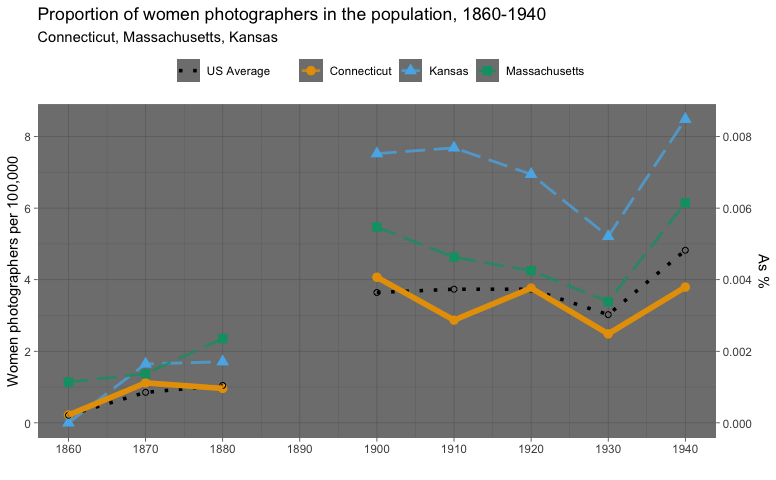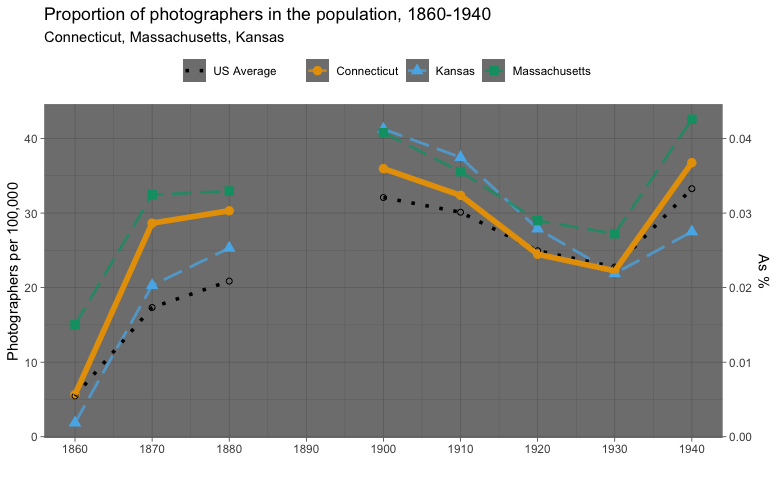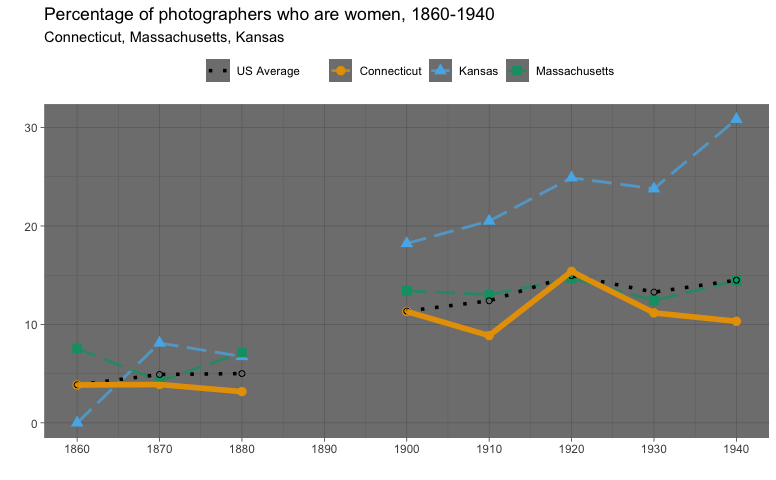Since Lee and I moved to Connecticut, we have been doing more research on early women artisan photographers here. One thing that has been striking is our impression that there are fewer women professional photographers here than in other states where we have already done more research, like Kansas and Massachusetts. We have wondered whether that impression was justified, or whether we were influenced by the amount of information available for Kansas (many online newspapers) and Massachusetts (the Steele and Polito compilation of 19th century photographers). To see whether Connecticut really had fewer early women photographers, I decided to look at Census data.
There are lots of issues about the accuracy of U.S. Census data, but we assume that those issues are the same across states, so that any differences among states is real, not due to those extraneous issues. Another issue with the U.S. Census data is that different categories were used at different times. However, the IPUMS USA at the University of Minnesota team has done great work at normalizing many of the categories, especially occupations, across the Censuses. In what follows, I’ll be using U.S. Census data from IPUMS [paper references below] that I downloaded and analyzed.
The simple approach to looking at whether Connecticut had fewer women photographers than Kansas and Massachusetts is to look at the raw numbers. Below is a chart showing those. Note that there is no data from 1890, since those Census records were most unfortunately destroyed in a fire. In addition, even though our project covers the years 1840-1930, I’ve excluded the 1840 and 1850 Censuses since there are no photographers recorded in those Censuses (even though there are photographers during these decades, including in Connecticut. As well, I’ve included the 1940 Census for comparison with the period just beyond our project.

It’s clear that Connecticut has the fewest women photographers of the three states. However, the raw numbers don’t necessarily tell the whole story, since the states had different populations. For example, Massachusetts has always had more people than Connecticut. To take into account the different population sizes, here’s a chart that looks at the percentage of women photographers out of the whole population.

From this perspective, we see that Kansas has proportionally more photographers than Massachusetts, though unfortunately Connecticut remains below both, and even below the U.S. average for most of the years.
We can also look at how common professional photographers were in general. Here we see a slightly different story, especially in the 19th century, where professional photographers were proportionally more common in Connecticut than in Kansas. In addition, in the 20th century, Connecticut is roughly at or somewhat above the national average, though still below Kansas and Massachusetts.

The differences between the proportions of women photographers and of photographers as a whole leads us to look directly at the proportion of women photographers among all photographers.

Here, the differences between Connecticut and Massachusetts are less strong, though Connecticut still generally lags behind. Kansas on the other hand, still largely out distances both Connecticut and Massachusetts for the proportion of women photographers among all photographers, especially in the 20th century.
To sum up, our initial impressions were correct: on all the measures here, Connecticut indeed had fewer professional women photographers than Kansas and Massachusetts. Figuring out why that might be will be much harder.
References
Chris Steele and Ronald Polito, A Directory of Massachusetts Photographers, 1839-1900 (Camden, Me.: Picton Press, 1993). Also available online at http://archive.org/details/directoryofmassa00stee.
Steven Ruggles, Sarah Flood, Matthew Sobek, Daniel Backman, Annie Chen, Grace Cooper, Stephanie Richards, Renae Rodgers, and Megan Schouweiler. IPUMS USA: Version 15.0 [dataset]. Minneapolis, MN: IPUMS, 2024. https://doi.org/10.18128/D010.V15.0
Steven Ruggles, Matt A. Nelson, Matthew Sobek, Catherine A. Fitch, Ronald Goeken, J. David Hacker, Evan Roberts, and J. Robert Warren. IPUMS Ancestry Full Count Data: Version 4.0 [dataset]. Minneapolis, MN: IPUMS, 2024.https://doi.org/10.18128/D014.V4.0